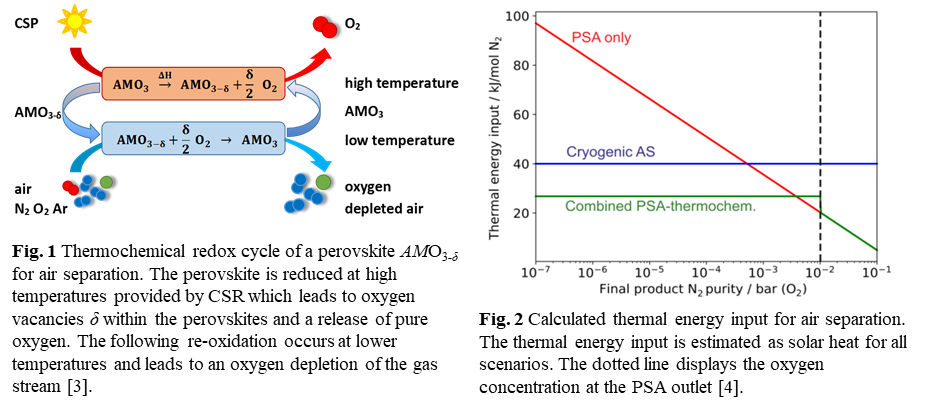(659g) Sustainable Thermochemical High-Purity Nitrogen Production Using Redox Oxides
AIChE Annual Meeting
2020
2020 Virtual AIChE Annual Meeting
Sustainable Engineering Forum
Symposium on Solar Power and Chemical Systems in Honor of Prof. Aldo Steinfeld IX
Friday, November 20, 2020 - 9:45am to 10:00am
Ammonia is synthesized via the Haber-Bosch process. The process itself has high energy consumption (32 MJ kg-1) [2] and the required nitrogen is predominantly produced via energy intensive cryogenic air separation. An alternative method utilizes thermochemical cycles where a redox material is reduced at high temperature accompanied by a release of oxygen. At lower temperatures the material is oxidized and thus takes the oxygen from the incoming gas (see Fig. 1). An advantage of this method is the opportunity to use concentrated solar radiation (CSR) for the heat supply and therefore, providing a sustainable nitrogen production.
Perovskites are often used as redox material. They are described with the general formula AMO3-δ, where A are alkali, alkaline earth or rare earth metal cations and the M site is occupied in most cases by transition metal cations. δ (δ = 0 – 0.5) indicates an oxygen non-stoichiometry. The partial reduction, which is described by Eq. 1, depends on the partial oxygen pressure pO2 and Temperature T. During the reduction the perovskites maintain their crystal structure, only smaller distortions are observed. This enables fast redox kinetics (reactions are completed in less than one min) and highly reversible redox cycles with long lifetime expectancy [3].
AMO3 ↔ AMO3-δ + δ/2 O2 (1)
For the Haber-Bosch process oxygen impurities of 3 ppm in N2 can be tolerated [2]. Therefore, it is essential to produce high-purity N2. A recent publication has proven that this is possible with thermochemical cycling using pre-purified air (1% O2) and SrFeO3-δ as redox material [5]. For the pre-purification of the air a pressure swing absorption devise (PSA) can be used. Economic analysis reveals that a combined solar-electrical driven PSA with a thermochemical system requires a lower thermal energy input than both solely solar-electrical driven PSA and solar-electrical cryogenic distillation (see Fig 2.).
Based on this analysis, the focus of the current work is the coupling of a PSA devise to a thermochemical reactor for the production of high-purity nitrogen. We present the concept design for this completely new approach, as well as an optimization of the process parameters based on thermochemical process simulations. Another field of research for improving the efficiency of thermochemical air separation is material science. The used perovskites determine the required temperatures and the achievable oxygen partial pressures. Doping of SrFeO3-δ and CaMnO3-δ leads to improved redox performance by either stabilizing the crystal structure and preventing phase changes, increasing the oxygen affinity or reducing the reduction and oxidation temperatures. We show the results of this material development and its positive effects on nitrogen production.
References
- https://pubs.usgs.gov/periodicals/mcs2020/mcs2020.pdf, 7th April 2020
- J.R. Jennings, Catalytic ammonia synthesis: fundamentals and practice, Springer Science & Business Media, 2013
- Vieten, J.; Bulfin, B.; Call, F.; Lange, M.; Schmücker, M.; Francke, A.; Roeb, M.; Sattler, C.; J. Mater. Chem. A 2016, 4 (35), 13652-13659
- J. Vieten, D. Guban, B. Lachmann, B. Bulfin, D. Krauzner, 2019, patent no DE 10 2019 126 114.7
- Bulfin, B.; Lapp, J.; Richter, S.; Gubàn, D.; Vieten, J.; Brendelberger, S.; Roeb, M.; Sattler, C.; Chem. Engineering Science, 2019, 203, 68-75
Checkout
This paper has an Extended Abstract file available; you must purchase the conference proceedings to access it.
Do you already own this?
Log In for instructions on accessing this content.
Pricing
Individuals
| AIChE Pro Members | $150.00 |
| AIChE Emeritus Members | $105.00 |
| AIChE Graduate Student Members | Free |
| AIChE Undergraduate Student Members | Free |
| AIChE Explorer Members | $225.00 |
| Non-Members | $225.00 |

